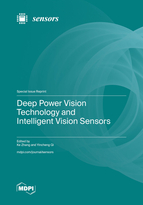Deep Power Vision Technology and Intelligent Vision Sensors
A special issue of Sensors (ISSN 1424-8220). This special issue belongs to the section "Sensing and Imaging".
Deadline for manuscript submissions: closed (31 October 2023) | Viewed by 16384
Special Issue Editors
Interests: computer vision; deep learning; power vision technology; facial attributes analysis
Special Issues, Collections and Topics in MDPI journals
Interests: power vision technology; power information technology; deep learning
Special Issues, Collections and Topics in MDPI journals
Special Issue Information
Dear Colleagues,
Deep power vision technology is the application of deep learning-based computer vision technology in power systems and is an important component of power artificial intelligence technology. The electric power system is the important and key national infrastructure, and its safe and stable operation is related to the national economy and people’s livelihood as well as the sustainable development of the economy and society. At present, there is an increasing number of inspection images and videos obtained through vision sensors on helicopters, unmanned aerial vehicles, and robots. In order to improve the efficiency of power inspection and ensure the safe and stable operation of the electric power system, it has become a necessary and urgent task to apply computer vision and deep learning to visual processing of the goals and defects of power plants, transmission lines, substations, and distribution lines in electric power systems.
The goal of this Special Issue is to provide a platform for exchanges on research works, technical trends, and practical experience related to deep power vision technology and intelligent vision sensors. We are soliciting original papers of unpublished and completed research that is not currently under review by any other conference/magazine/journal. Topics of interest include but are not limited to the list below:
- Deep learning-based computer vision technology in transmission or distribution line inspection
- Deep learning-based computer vision technology in substation inspection
- Deep learning-based computer vision technology in power plants inspection
- Lightweight models for intelligent vision sensors
- Model compression for intelligent vision sensors
Prof. Dr. Yincheng Qi
Guest Editors
Manuscript Submission Information
Manuscripts should be submitted online at www.mdpi.com by registering and logging in to this website. Once you are registered, click here to go to the submission form. Manuscripts can be submitted until the deadline. All submissions that pass pre-check are peer-reviewed. Accepted papers will be published continuously in the journal (as soon as accepted) and will be listed together on the special issue website. Research articles, review articles as well as short communications are invited. For planned papers, a title and short abstract (about 100 words) can be sent to the Editorial Office for announcement on this website.
Submitted manuscripts should not have been published previously, nor be under consideration for publication elsewhere (except conference proceedings papers). All manuscripts are thoroughly refereed through a single-blind peer-review process. A guide for authors and other relevant information for submission of manuscripts is available on the Instructions for Authors page. Sensors is an international peer-reviewed open access semimonthly journal published by MDPI.
Please visit the Instructions for Authors page before submitting a manuscript. The Article Processing Charge (APC) for publication in this open access journal is 2600 CHF (Swiss Francs). Submitted papers should be well formatted and use good English. Authors may use MDPI's English editing service prior to publication or during author revisions.








